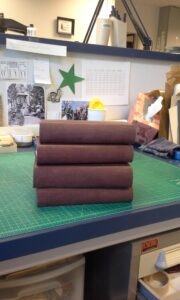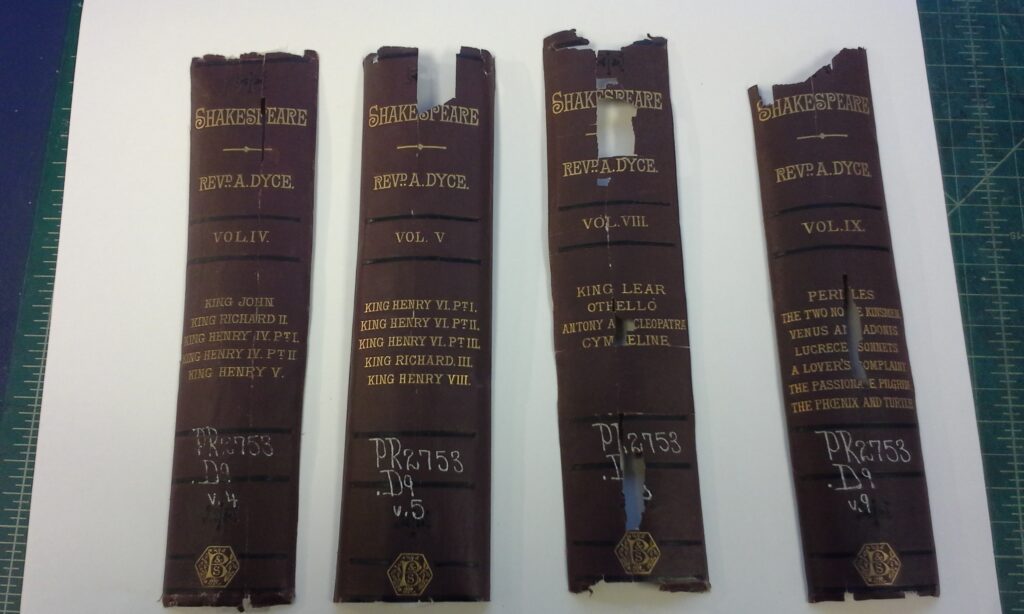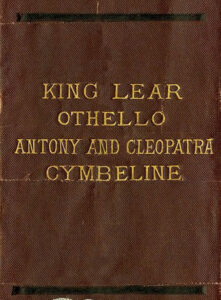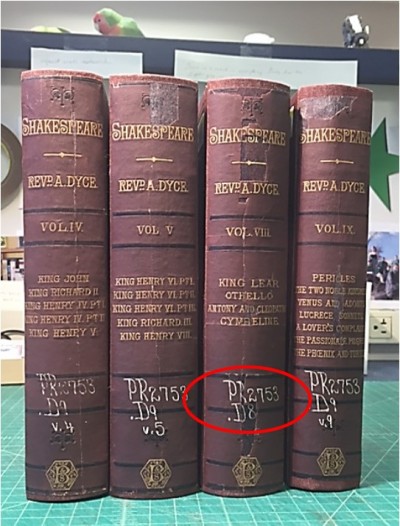I have four volumes of Shakespeare’s plays on my desk. They have been there for months. It feels like years. I want to send them on, but there are little problems with them that I created. Fairly simple problems, really. I could have them send on their way by the end of the week. And still there they sit. If they were beagle puppies they would look at me something like this:

Part of my hang up is that I used to be in a Shakespearean improv troupe. We were called the World’s Greatest Shakespeare Company. No kidding. The whole thing was beautiful and dark and deeply important to me. It dissolved by slow degrees a couple of years after I left to learn how to save books. I never really got over it. So I always try to grab the Shakespeare books when they come through for repair. It’s like I owe Shakespeare something.

But added to that compulsion, was the death of one of my fellow cast members. David was the handsome, brooding, Byronic hero type in the foreground of the above photo. He was the heart of our group. I did what you do in these cases. I flew to Arizona to sit stunned in a bar while the rest of the cast told funny stories. And then I flew home and didn’t feel very much better about it.
And shortly after that these books came across my desk:

I grabbed them and hung on for dear life. The books themselves aren’t so terribly special or rare. But I have this thing about Shakespeare. So I decided that I needed to pour everything into them. It would make me feel better. Work and therapy in one neat (well, actually pretty messy) package.
And at the same time I fell down a very different Shakespeare rabbit-hole. The friend I stayed with in Arizona had recently been reading Sweet Swan of Avon by Robin Williams (not that Robin Williams) and was pretty excited about it. My friend is a scientist and a basically rational person so I give her opinion a lot of weight. This book posits that this guy

Isn’t the one who wrote the plays and sonnets. It says that the most likely candidate is actually Mary Sidney. (Who is a very impressive woman in her own right, regardless of whether or not she wrote Shakespeare’s stuff. I encourage everyone to look her up.)

The book is well written and convincing, so I had spent some time reading up on other aspects of the Shakespearean authorship question. And was left wondering who really wrote these books that I was working on. My brain got sort of tangled up.
So there I am listening to Shakespearean Authorship Question podcasts and fussing over how best to repair these poor books. I don’t like to get too heavily into metaphor. That’s why I couldn’t bear to be an English major. But regardless who wrote them, I had certainly given these books more weight in my life than I would have if they had showed up a couple of months earlier.
This is what I did for them:
The text blocks were in very good shape, but the spines were badly deteriorated. So rebacking and spine repair seemed the way to go. The rebacking went smoothly, and I was able to get a good color match on the linen and Japanese tissue laminate. So far, so good.

Often, when book spines are pretty but deteriorated, I will scan them, clean up and repair the image in Photoshop and then just mount a printout of the repaired image in place of the original spine.
Here’s a simple example:


In the case of the Shakespeare books, though, I was determined to save as much of the original spines as I could. The cloth was workable, but the problem was that chunks of title were missing. So I decided to try to recreate just those parts to fill in the empty spaces.

First, I temporarily taped the worst bits together and scanned them on our flatbed scanner. My idea was that I could cut and paste bits from the more complete spines onto missing parts. I would print patches onto Japanese tissue and then paste them on to the missing areas. I had never tried printing on Japanese tissue before, and wasn’t sure how it would work. Plus, I figured it was going to test the limits of my Photoshop skills. New technique! Challenge! Therapy!
And stage one worked pretty well. I was able to get a nice clean scan of all four spine pieces. At this point I started the fiddly process of recreating the missing bits of text. If the letter appeared elsewhere, I tried to copy it and paste the image of the letter into the missing area. Sometimes there wasn’t an exact correlation and so I would just try to find a letter that was close and modify it by hand. For example, an “O” can become a “C” just by editing out a few pixels. There wasn’t a lot of this that needed to be done, and I was able to recreate the lists of play titles without too much trouble.


It took some more fiddling to get the printed color to match the book covers and some very stern conversations with the printer to convince it that a medium-weight Japanese tissue could be printed on without jamming. Eventually, the printer and I got it right.
I was able to mend the broken pieces of spine from the back using a lightweight tissue and fairly thick wheat starch paste. Too much water would have bled through and caused the color to run or smear off.
Then, again from the back, I pasted the printed Japanese tissue into place to fill out the missing information or design elements. Once that was dry, I mounted the spines back onto the books.
And then I made a mistake. They dried beautifully, but I thought it might be a good idea to brush a little paste over the front of the printed areas to make sure they were really sticking nicely. And that completely clouded over the images. But since the spines were already attached to the books, there wasn’t a lot to do about it. Lesson learned. If it looks good – leave it alone.
In spite of my improper use of paste, I was basically happy with the result and ready to give the books a big (but sort of sad) hug and send them on their way. And then I saw my other mistake.
Back when the books were accessioned (1948, if the notation on the title pages is correct) someone had carefully hand lettered the call numbers onto the spines in white ink. I was really quite proud of my recreation of the call number on Volume 8. Except that I put on the wrong call number. The last two figures should be D9, followed by v.8. Well crap.

I can’t lift the spine back off to replace the printed piece. If I do, I’m afraid the original pieces of the spine will come to pieces. And I’m really not sure what to do about it. I’m trying very hard not to listen to the treacherous voice in my head saying “Just make an enclosure with the correct spine label and no one will ever notice.”
But I need to make it right. I’ve been hoarding these books for far too long to send them back out into the world with a mistake like that. Not to mention best practices and so on. So I think I will try to make a new Japanese tissue patch with the correct call number and paste it over my mistake. And maybe a bit of paint over those cloudy areas. My mother is fond of saying “The perfect is the enemy of the good. And the done.” But these books have been with me for such a long time now, and I have given them so much weight of meaning that it will be hard so send them on.
A quote from one of my favorite novels seems relevant:
“I can see rereading The Lord of the Rings instead of studying for finals, but why clean your closet?”
– Tam Lin, by Pamela Dean
I have spent quite a bit of time this week cleaning my workbench. And last Saturday (April 23, 2016) has been widely celebrated as the 400th anniversary of Shakespeare’s death. So I guess now it’s time to get to work.
Leave a Reply